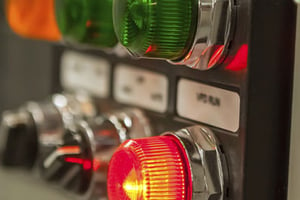Have you ever wondered why some power ratings are expressed in WATTS, some in AMPERES or AMPS, some in VOLTS, and some in KVA? This page will explain in simple terms the difference between the power ratings and describe when each should be used in your data center and network architecture planning.
A KVA is simply 1,000 volt amps. A volt is electrical pressure. An amp is electrical current. A term called apparent power (the absolute value of complex power, S) is equal to the product of the volts and amps.
On the other hand, a watt (W) is a measurement of real power. Real power is the amount of actual power that can be drawn from a circuit. When the voltage and current of a circuit coincide, the real power is equal to the apparent power. However, as waves of current and voltage coincide less, less real power is transferred, even though the circuit is still carrying current. Differences between real and apparent power, and thus watts and volt amps, arise because of inefficiencies in electrical transmission.
The resulting inefficiency of electrical transmission can be measured and expressed as a ratio called the power factor. The power factor is a ratio (a number from 0 to 1) of real power and apparent power. In the case of a 1.0 power factor, the real power equals the apparent power. In the case of a 0.5 power factor, real power is approximately half that of the apparent power.
Deploying systems that have higher power factors result in less electrical loss and can help improve your Power Usage Effectiveness (PUE). Most Uninterruptible Power Supply (UPS) units will list the average power factor and real-time load capacity of the UPS, in addition to the KVA.
Example: You own a 500 KVA UPS unit (apparent power) with a 0.9 power factor. The resulting real power is 450 kilowatts.
Some Useful Conversion Factors and Formulas
- VA = Voltage x Amps
- Watts = Voltage (root-mean-squared) x Amps (root-mean-squared) x Power Factor (PF) (a three-phase circuit would multiply the voltage by the square root of 3 or approximately 1.732)
- 1 BTU (British thermal unit) = Watts x 3.413
- 1 BTU = 1,055.053 joules (J)
- 1 watt = 3.413 BTU/hour
- 1 ton = 200 BTU/minute
- 1 ton = 12,000 BTU/hour
- 1 ton = 3.517 kilowatts










